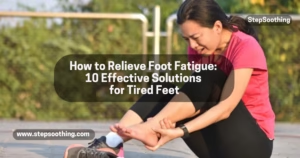Your shoe insoles are a vital part of your footwear that provide support and comfort. Over time, they break down, losing their effectiveness and causing pain in your feet, knees, or even your back. If you feel ache or discomfort during day-to-day activities, it might be time for a replacement. Worn-out insoles can lead to long-term tissue damage, so knowing when to change them is essential.
Look for signs like reduced cushioning, poor fit, or increased foot-related conditions. Insoles don’t last forever, and ignoring their deterioration can cause foot fatigue. If your shoes no longer feel comfortable, getting new insoles is the answer to keep your feet healthy and alleviating pain.
A Comprehensive Guide on How Long Do Insoles Last

What Are Insoles?
Insoles are padded inserts placed inside a shoe to improve fit and provide extra support. They fill empty spaces, reducing the risk of injury, blisters, and calluses. A well-fitted insole can prevent foot-related conditions while making your footwear more comfortable. Made from different material types, insoles come in foam, gel, leather, and cork. Choosing the right insole ensures proper arch support, better weight distribution, and reduced foot strain.
The Best Reasons to Buy New Insoles
If you experience pain relief after changing your insoles, it’s clear why it’s important to replace them periodically. Good insoles keep your feet well-supported throughout the day, especially if you stand or walk a lot. They also reduce the risk of foot conditions and injury. Wearing old insoles can prevent proper alignment, leading to worsening foot problems. Orthotic Insoles are particularly beneficial for people who need extra foot support due to conditions like plantar fasciitis or flat feet.
How Often Should You Replace Your Insoles?
If you’re wondering when to change your insoles, consider your activity levels. Typically, insoles last between six to twelve months, but if you engage in high-impact sports or daily intensive use, you might need replacement sooner. Factors like quality, frequent use, and material breakdown determine longevity. If you wear your shoes daily, monitor signs of wear and tear to maintain foot health.
4 Signs That You Need Replacement Insoles
- Discoloration – The first sign of a worn-out insole is when its color has changed or the logo has faded.
- Visible Damage – Look for marks, ripped, cracked, or torn material.
- Loss of Support – Over time, insoles lose their original shape, density, and compression.
- Unpleasant Odor – If you live an active lifestyle, sweat and moisture get trapped, leading to fungus, bacteria, and potential infection.
What to Look for in Replacement Insoles
Finding the right size for your foot and shoe is critical for proper fit. Consider your arch type—whether normal, flat-footed, or high—to choose the right insole. Arch support insoles are especially useful for maintaining foot structure. Materials like foam, gel, or wool each have their advantages. Cushioning, shock absorption, and durability depend on activity levels. If you engage in high-impact activities, prioritize support and longevity.
How Long Do Insoles Last (By Material)?
Different material types have varied durability. Foam insoles wear out the quickest due to their lightweight nature. Memory foam and polyurethane last longer but still compress over time. Plastazote is soft yet durable, but quality, use frequency, weight, and activity levels affect lifespan. Watch for visible signs like flattening and odor to determine when it’s time for a change.
How Long Do Memory Foam Insoles Last?
Memory foam insoles are popular because they conform to your natural foot shape. However, their quality and ability to support decrease with pressure and standing for long hours. They typically have a shorter lifespan, so monitor their compression regularly to ensure ongoing comfort and foot health.
How Long Do Gel Insoles Last?
Known for shock absorption, Gel Insoles have a longer shelf life than foam but still wear down over time. Temperature exposure and quality affect their longevity, and they may need replacement sooner. Materials like cork, memory foam, and leather offer different durability levels, with gel falling somewhere in between.
How Long Do Cork Insoles Last?
Cork insoles are durable and mold to your foot shape with regular use. However, moisture exposure and sweating can break them down. If you see cracks, crumbling, or experience a persistent odor, it’s time to replace them.
How Long Do Leather Insoles Last?
Leather insoles are known for their durability, and with proper care, they can last a max of 2 years. Cleaning, conditioning, and using cedar shoe trees can extend their life. Rotating them between shoes and checking for wear-through spots or smell helps maintain longevity.
Benefits of Changing Your Insoles
Replacing insoles keeps your shoes fresh and improves comfort. It restores cushioning, enhances support, and maintains foot alignment. Changing insoles regularly helps prevent injuries and health issues while increasing their lifespan. Learn more about the Benefits of using Insoles to understand how they enhance foot health and prevent discomfort.
People Also Ask
How long do insoles typically last?
Most insoles last six to twelve months, but daily use, high-impact sports, and material quality can affect their lifespan.
Can I extend the life of my insoles?
Yes! Regular cleaning, drying properly, and rotating shoes can help prevent breakdown and maintain support for a longer time.
What happens if I don’t replace my insoles?
Worn-out insoles can cause pain, discomfort, and misalignment, leading to joint issues, injuries, and an overall reduced shoe lifespan.
Can insoles be transferred between different shoes?
Yes, but they must fit correctly to provide proper support, comfort, and prevent slipping inside the shoe.
What materials last the longest?
Leather and cork insoles last longer with proper care, while foam and gel insoles wear out faster.



